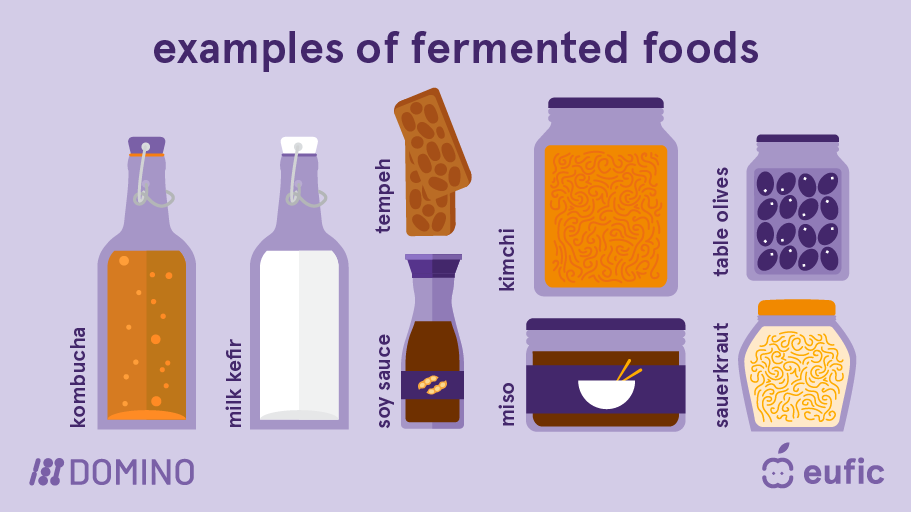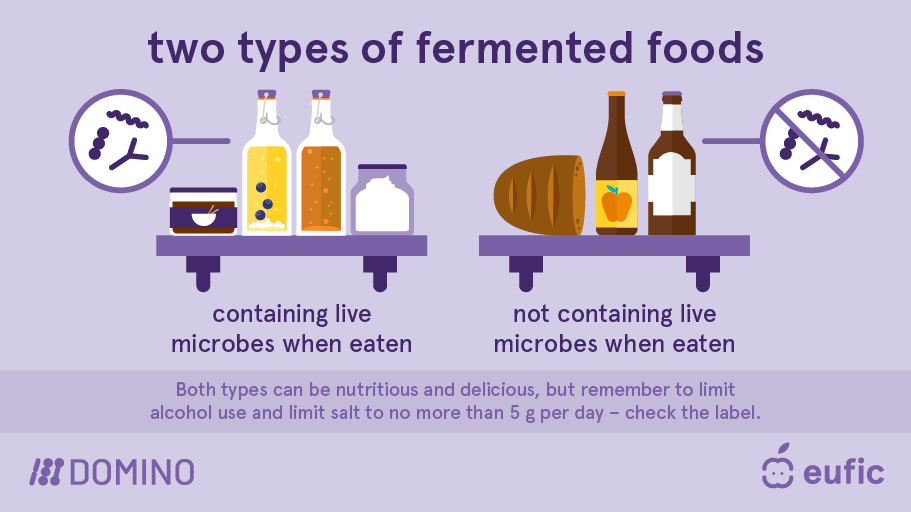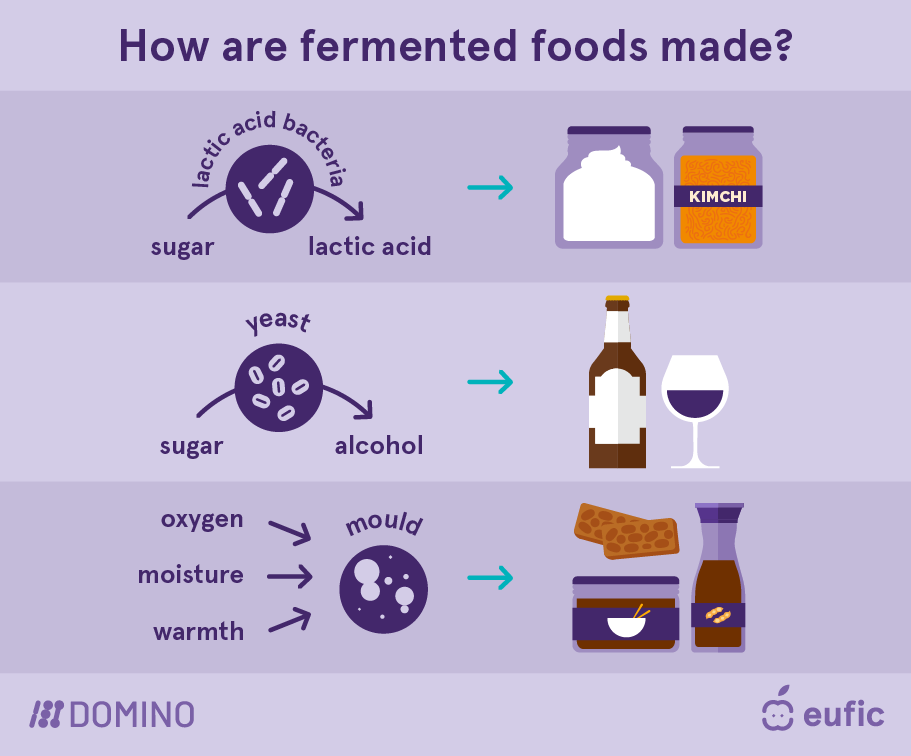Fermented foods: What are they, and what is their impact on our health?
Last Updated : 21 June 2024
Fermented foods have been consumed around the world for centuries. Today, they endure in kitchens, restaurants and markets, where an estimated 5000 types of fermented foods are eaten worldwide, making up 5-40% of human diets.1,2As certain foods and beverages such as sourdough bread and kombucha rise in popularity and receive trend-worthy recognition, it begs the question: what exactly are fermented foods, and are they good for our health? Let’s break it down.
What are fermented foods?
Fermented foods and beverages are made through desired microbial growth and enzymatic conversions of food components.3 This process breaks down complex nutrients present in the food into simpler components, bringing advantageous changes in the taste, texture, digestibility and preservability of the food.
A multitude of foods and beverages commercially accepted and regularly eaten are made possible through the art of fermentation. For instance, cheese, sauerkraut, salami and yogurt are fermented. When it comes to beverages, fermentation can transform grapes into wine, cereals into beer, honey into mead, apples into cider, tea into kombucha and cacao into chocolate.4 Many condiments are also fermented, such as soy sauce, fish sauce, miso or gochujang (a Korean red chili paste).
Many regions boast their own specific traditional fermented foods. Take France, where you can find a range of fermented goods, from yoghurts, cheeses and crème fraiche to dry sausages (“saucisson”). In Japan, fermentation has brought us products like miso paste and natto, both made from fermented soybeans. Popular in Eastern European countries, milk kefir (tart and tangy fermented milk) and kvass (fermented rye bread) are classic choices. The sour and spongy Ethiopian flatbread, injera, is made from fermented teff flour. Fermented cabbage alone takes on several forms, from the tangy and spicy kimchi from Korea, El Salvador’s curtido cabbage slaw, to Germany’s national dish, sauerkraut. The list goes on with daily delicacies like handvo (fermented rice and lentils) from India, tempeh (fermented soybeans or other beans) from Indonesia, balao-balao (fermented rice and shrimp) from the Philippines and surströmming (fermented herring) from Sweden.5

Fig. 1 – Examples of fermented foods and beverages
We can classify fermented foods into those which retain living microbes, and those that do not. For example, while sourdough bread is fermented, when it undergoes a ‘heat treatment’ (baking), the living microbes do not survive, and thus do not reach our gut. This is also the case for products that are pasteurised, such as ciders. Nonetheless, fermented foods that do not contain living microbes in their final format can still be nutritious and delicious, as the process of fermentation can yield other significant health benefits.6

Fig. 2 – Fermented foods containing living microbes vs. those without living microbes
Given modern methods of food preservation, the need to ferment foods solely to prevent their spoilage has been reduced. However, these traditional fermented foods are still popular in the culinary world, partly due to their exciting tastes and textures, but also due to their health-promoting potentials and for their contributions to sustainable food production. 7, 8For example, fermentation can contribute to reducing food waste by extending the shelf-life of foods and offer a way to use surplus or imperfect produce that might otherwise be wasted.
Summary
Enjoyed globally, fermented food places itself as an important category of food products for human and environmental health – and the opportunities for fermenting novel products, while continuing to enjoy traditional recipes, are just on the cusp.
How are fermented foods made?
There is a very precise science behind food fermentation. When foods are fermented, they go through a biological process whereby microorganisms, mainly bacteria, yeast or moulds, undergo controlled growth. This process turns some of the energy rich nutrients found in food, like carbohydrates, into by-products like alcohols or organic acids. 6, 9
Bacterial-inspired fermentation mostly involves a broad range of species called lactic acid bacteria, which are bacteria that feed on the sugars present in foods to convert them into lactic acids. This gives us the tangy, sour flavours of many fermented dairy products (yoghurt, sour cream) and fermented vegetables (sauerkraut, kimchi). Meanwhile, yeast is the microbial vehicle for alcohol fermentation, where it converts sugars into ethanol alcohol and carbon dioxide (as the case for products like wine, beer or mead). There are also symbiotic fermentation processes where two types of fermentation happen at the same time, or one happens before the other. For example, both yeast and bacteria fermentation take place to create products like vinegar, sourdough bread, kombucha and milk/water kefir. Lastly, while typically associated with food spoilage, mould-based fermented foods are formed in environments where oxygen, moisture and warmth are present in balanced, controlled proportions. This type of fermentation is behind blue cheese, as well as miso, tempeh, or soy sauce, where a Japanese mould called ‘koji’ is in play.10

Fig. 3 – The three common food fermentation processes.
Summary
Fermentation gives ‘ordinary’ raw materials a makeover, where microorganisms work to manipulate the texture, appearance, colour, taste and flavour of raw foods. The process also transforms foods which may spoil quickly into a new food that stay safe to eat for months, diverting food waste into often nutritious and value-added products.
What are the health benefits of fermented foods?
Scientists are investigating how exactly fermented foods affect our bodies and health and how they can modulate the gut microbiome and improve gut health.10
So what exactly is 'gut health'? Firstly, it may help to understand the gut microbiome – which describes the community of microorganisms that occupy the gut, and also considers how the different microorganisms interact with each other and their environment.11When we eat fermented foods that contain live microbes, this increases the numbers of live microorganisms in the gut. In turn, this can contribute to a diverse microbiome. While a clear definition of a healthy gut microbiome does not yet exist, research suggests that this diversity in out gut makes our microbiome more capable and resilient.12 A capable and resilient microbiome may help our gut withstand challenges like dietary changes or antibiotic treatments, while also preventing harmful imbalances (dysbiosis) which can negatively impact health.13
In terms of other health benefits, many fermented foods contain bioactive peptides or other small molecules, which have promising outcomes on health such as reducing oxidative stress with their antioxidant effect.14 For example, fermented olives are rich in polyphenols, compounds with significant antioxidant activity that can promote human health by protecting body tissues, cells, membranes, and lipids from oxidative damage, reducing cardiovascular risk factors, and having anti-inflammatory effects. This is primarily attributed to their content of monounsaturated fat (MUFA), vitamin E, and hydroxytyrosol (HT).15
Additionally, observational studies have linked eating fermented dairy products (i.e., cheese, yoghurt and sour milk products like kefir) with a lower risk of type 2 diabetes.16 Positive effects have also been found on body composition, lowering cholesterol and protecting against the risk of , such as cardiovascular diseases.17 For example, for every 10 g of cheese per day, a 2% reduction in cardiovascular disease risk was observed.16 Nonetheless, more research is needed to understand the certainty of these findings.18
Fermented products can also help with digestion. For example, some fermented dairy products have been found to help improve lactose digestion and tolerance.19 Some research has also found that sourdough bread can be easier to digest for people with irritable bowel syndrome.5 Fermenting can also improve the quality and digestibility of protein and the levels of certain vitamins in food, notably B vitamins.12, 20 Some fermented soybean products like tempeh, natto, and soy sauce have been observed to help reduce the levels of substances that interfere with nutrition absorption (such asphytic acid and trypsin inhibitors). This can help make nutrients, such as proteins, easier for our bodies to digest and use.21
Are fermented foods safe?
The words bacteria and mould may not immediately come to mind as a positive association to food. In fact, when microorganisms were first discovered in the 17th century, their primary contribution was recognised as spoiling food and causing diseases. However, their positive impacts on human health were discovered not long after.12
According to the General Food Law Regulation, foods marketed in Europe must legally be safe for consumption.22 Hence, the fermented foods found in our supermarkets must meet the same standards as anything else on the shelf and be safe to eat. In fact, the microbial activities during the fermentation process can even enhance food safety by reducing the growth of harmful microorganisms.7But, as with all foods, illness can result if disease-causing microorganisms contaminate the food, for instance through poor hygiene or incorrect storage.
Following basic food safety measures is just as crucial for fermented foods. While it’s characteristic for many fermented foods to naturally develop flavours or textures as they age, it's important to be familiar with how different foods typically undergo ageing to distinguish between normal changes and signs of spoilage. For example, although mould is intentionally present in blue cheese, excessive mould growth or mould of a different colour may indicate spoilage. It’s always key to follow the use-by-date on the packaging!
When fermenting at home, it is important to rinse produce, wash hands thoroughly, and use clean utensils, containers and surfaces. Use tried and tested recipes, as the ingredient ratios will have been optimised to get the right acidity levels for maximising safety.
So, what is the recommendation? Should we consume fermented foods for health?
Despite having held an important place in the human diet for centuries, fermented foods as a food group are rarely specifically recommended in current food-based dietary guidelines. Due to the evidence-based benefits, some researchers suggest to include fermented foods in national dietary guidelines worldwide, to support consumer awareness of their role as part of a healthy diet.23
To improve relevant dietary recommendations based on fermented foods, further research is needed to understand the role of the food microbial diversity as an essential component for maintaining human health.24 The DOMINO project is exploring how fermented foods shapes the gut microbiome and provides health benefits to consumers. This project will contribute to a better understanding of how dietary recommendations based on fermented foods can support individuals with metabolic syndrome.
Hungry for more?
Curious about adding more fermented food flavours to your diet? You could start by putting yoghurt in smoothies, having miso soup for lunch, or a serving of sauerkraut alongside your dinner, snacking on toasted sourdough bread with cheese, or drinking a refreshing kefir. Eating fermented foods can add diverse and satisfying flavours and textures to our diet!
The DOMINO project has received funding from the European Union’s Horizon Europe research and innovation programme under grant agreement No 101060218.


References
- Plessas S (2022). The Rendering of Traditional Fermented Foods in Human Diet: Distribution of Health Benefits and Nutritional Benefits. Fermentation 8(12), 751. doi: 10.3390/fermentation8120751
- Bell V et al. (2018). One Health, Fermented Foods, and Gut Microbiota. Foods. 7(12): 195. doi: 10.3390/foods7120195
- Marco ML, Sanders ME, Gänzle M, Arrieta MC, Cotter PD, De Vuyst L, Hill C, Holzapfel W, Lebeer S, Merenstein D, Reid G, Wolfe BE, Hutkins R. The International Scientific Association for Probiotics and Prebiotics (ISAPP) consensus statement on fermented foo
- Ferreira L.J.C. et al. (2023). Coffee fermentation process: A review. Food Research International. Volume 169, 112793. ISSN 0963-9969. doi: /10.1016/j.foodres.2023.112793.
- Cuamatzin-García L et al. (2022) Traditional Fermented Foods and Beverages from around the World and Their Health Benefits. Microorganisms. 10(6):1151. doi: 10.3390/microorganisms10061151. PMID: 35744669; PMCID: PMC9227559
- Arora R, Chandel A.K. (2023). Unlocking the potential of low FODMAPs sourdough technology for management of irritable bowel syndrome. Food Research International. Volume 173, Part 2, 113425. doi: 10.1016/j.foodres.2023.113425.
- Valentino V et al. (2024). Fermented foods, their microbiome and its potential in boosting human health. Microb Biotechnol. 17(2):e14428. doi: 10.1111/1751-7915.14428.
- Rastogi Y.R. et al. (2022). Food fermentation – Significance to public health and sustainability challenges of modern diet and food systems. International Journal of Food Microbiology. Volume 371,109666. ISSN 0168-1605. doi: 10.1016/j.ijfoodmicro.2022.1096
- Voidarou C et al. (2020). Fermentative Foods: Microbiology, Biochemistry, Potential Human Health Benefits and Public Health Issues. Foods. 10(1):69. doi: 10.3390/foods10010069.
- Shah A.M et al. (2023). Fermented Foods: Their Health-Promoting Components and Potential Effects on Gut Microbiota. Fermentation. 9, 118. doi: 10.3390/ fermentation9020118
- Berg G, et al. (2020). Microbiome definition re-visited: old concepts and new challenges. Microbiome 8 (103).
- Lozupone, C. A., Stombaugh, J. I., Gordon, J. I., Jansson, J. K., & Knight, R. (2012). Diversity, stability and resilience of the human gut microbiota. Nature, 489(7415), 220-230
- Dogra SK, Doré J, Damak S. (2020). Gut Microbiota Resilience: Definition, Link to Health and Strategies for Intervention. Front Microbiol. Sep 15;11:572921. doi: 10.3389/fmicb.2020.572921.
- Akbarian M et al. (2022). Bioactive peptides: Synthesis, sources, applications, and proposed mechanisms of action. International Journal of Molecular Sciences, 23(3), 1445.
- Rocha et al. (2020). Table olives and health: A review. Journal of Nutritional Science, 9, e57.
- Awwad S.F. et al. (2022). Invited review: Potential effects of short- and long-term intake of fermented dairy products on prevention and control of type 2 diabetes mellitus. J Dairy Sci.105(6):4722-4733. doi: 10.3168/jds.2021-21484.
- Astrup A, Geiker N.R.W., Magkos F. (2019) Effects of Full-Fat and Fermented Dairy Products on Cardiometabolic Disease: Food Is More Than the Sum of Its Parts. Adv Nutr. 10(5):924S-930S. doi: 10.1093/advances/nmz069.
- Estruch, R., Lamuela-Raventós, R.M. (2023). Cardiovascular benefits of fermented foods and beverages: still up for debate. Nat Rev Cardiol 20, 789–790. doi: 10.1038/s41569-023-00938-3
- Savaiano D.A., Hutkins R.W. (2021). Yogurt, cultured fermented milk, and health: a systematic review. Nutr Rev. 79(5):599-614. doi: 10.1093/nutrit/nuaa013.
- Melini F et al. (2019). Health-Promoting Components in Fermented Foods: An Up-to-Date Systematic Review. Nutrients. 11(5):1189. doi: 10.3390/nu11051189.
- Terefe (2016). Food Fermentation. Reference Module in Food Science. doi: 10.1016/B978-0-08-100596-5.03420-X.
- Regulation (EC) No 178/2002 of the European Parliament and of the Council of 28 January 2002 laying down the general principles and requirements of food law, establishing the European Food Safety Authority and laying down procedures in matters of food.
- Diez-Ozaeta I, Astiazaran O.J. (2022). Fermented foods: An update on evidence-based health benefits and future perspectives, Food Research International. Volume 156, 111133. doi: 10.1016/j.foodres.2022.111133.
- O’Donnell, et al. (2018). The use of a mini-bioreactor fermentation system as a reproducible, high-throughput ex vivo batch model of the distal colon. Frontiers in Microbiology, 9.
